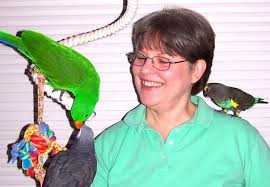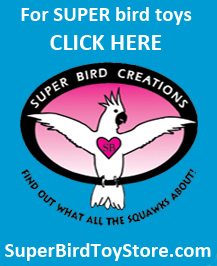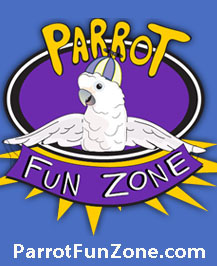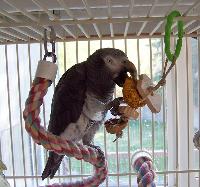 Try baking your favorite birdie bread recipes in mini-muffin pans. Use the end of a wooden spoon to put a hole in each muffin before putting them in the oven. This enables you to string the birdie bread on toys which creates a foraging experience for your parrot. Here is my parrot's favorite bird bread recipe:
Try baking your favorite birdie bread recipes in mini-muffin pans. Use the end of a wooden spoon to put a hole in each muffin before putting them in the oven. This enables you to string the birdie bread on toys which creates a foraging experience for your parrot. Here is my parrot's favorite bird bread recipe:
Curry Corn Bread
Dry ingredients:
3 cups stone ground cornmeal
3 cups stone ground whole grain flours (try for a mixture). Examples include amaranth, barley, garbanzo, oat, triticale, spelt. You can also just use whole wheat flour.
1 1/2 cups mixed rolled grains (usually found in the bulk food section of the grocery store or health food store). You can also just use rolled oats.
1 1/2 cups 7-grain cereal (this is a coarse ground cereal containing a mixture of grains like wheat, rye, triticale, barley, brown rice, oat bran, flaxseed, etc.)
1/3 to1/2 cup raw pumpkin seed
1/3 to1/2 cup raw sunflower seed
3/4 cup millet
1 tablespoon curry powder
Mix all of the dry ingredients above together in a very large mixing bowl.
Vegetables:
About 3 cups of finely chopped or grated vegetables (Examples: broccoli, beets, chayote squash, zucchini, greens [Swiss Chard, collard, kale, mustard], carrots, peas, corn, etc.)
Mix the vegetables in with the dry ingredients thoroughly so that they become well-coated with the flours and are no longer present in clumps.
Wet ingredients:
In a blender or food processor, puree the following together:
6 eggs
1 large can pumpkin (29 oz)
1 cup water or other liquid (carrot juice, almond milk, etc.)
Add the wet ingredients to the dry mixture and mix thoroughly. (You might need to use your hands, since this creates quite a dense dough.)
Place into mini muffin pans and bake at 350 degrees for about 25 to 30 minutes. Use one level tablespoon per muffin. Before baking, use the end of a wooden spoon to create a hole in the center of each muffin, which then allows you to place these onto food skewers or incorporate into foraging toys. Makes about 120 muffins.
This recipe can be halved quite easily. It also freezes quite well after baking.
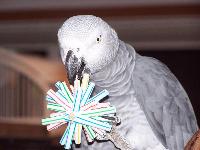 Here is a tip for a quick toy that your parrot may enjoy. Cut some plastic straws in half. Poke a hole in the center of each straw half. Take a short length of rope (I use hemp rope) about 8 inches long. Tie a loop at one end and double knot it so the straws don't slide off. Thread on several straw halves. Tie them tightly together with another double knot at the end and fan them out to make a multi-dimensional star shape. You can hand it to your parrot as a foot toy or you can incorporate the straw stars into other toys that you make. For smaller parrots you would want to use shorter straw pieces, perhaps cutting the straws into thirds which will make stars smaller in diameter.
Here is a tip for a quick toy that your parrot may enjoy. Cut some plastic straws in half. Poke a hole in the center of each straw half. Take a short length of rope (I use hemp rope) about 8 inches long. Tie a loop at one end and double knot it so the straws don't slide off. Thread on several straw halves. Tie them tightly together with another double knot at the end and fan them out to make a multi-dimensional star shape. You can hand it to your parrot as a foot toy or you can incorporate the straw stars into other toys that you make. For smaller parrots you would want to use shorter straw pieces, perhaps cutting the straws into thirds which will make stars smaller in diameter.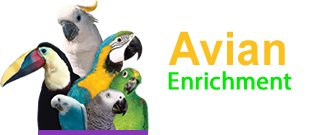

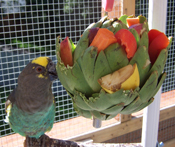 During the summer months I like to take advantage of the greater variety of fresh vegetables and fruits available at local markets. An artichoke strung on a stainless steel food skewer makes a great foraging toy and a wonderful item to put out in the aviary. You can stuff the leaves with a variety of fruits and vegetables:
During the summer months I like to take advantage of the greater variety of fresh vegetables and fruits available at local markets. An artichoke strung on a stainless steel food skewer makes a great foraging toy and a wonderful item to put out in the aviary. You can stuff the leaves with a variety of fruits and vegetables: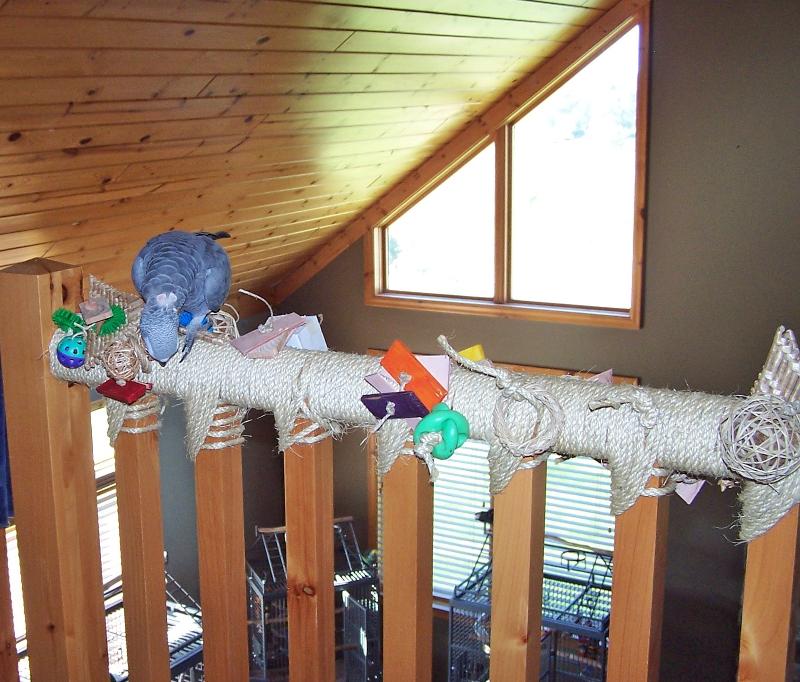 We recently moved from Alaska to Minnesota. I'm finding the parrots are chewing on woodwork in the new home and they are particularly interested in the banister outside the loft area above the living room. I didn't have this problem in the Alaska house. But the woodwork in that home had less detail, just a simple round wood banister and flat trim.
We recently moved from Alaska to Minnesota. I'm finding the parrots are chewing on woodwork in the new home and they are particularly interested in the banister outside the loft area above the living room. I didn't have this problem in the Alaska house. But the woodwork in that home had less detail, just a simple round wood banister and flat trim.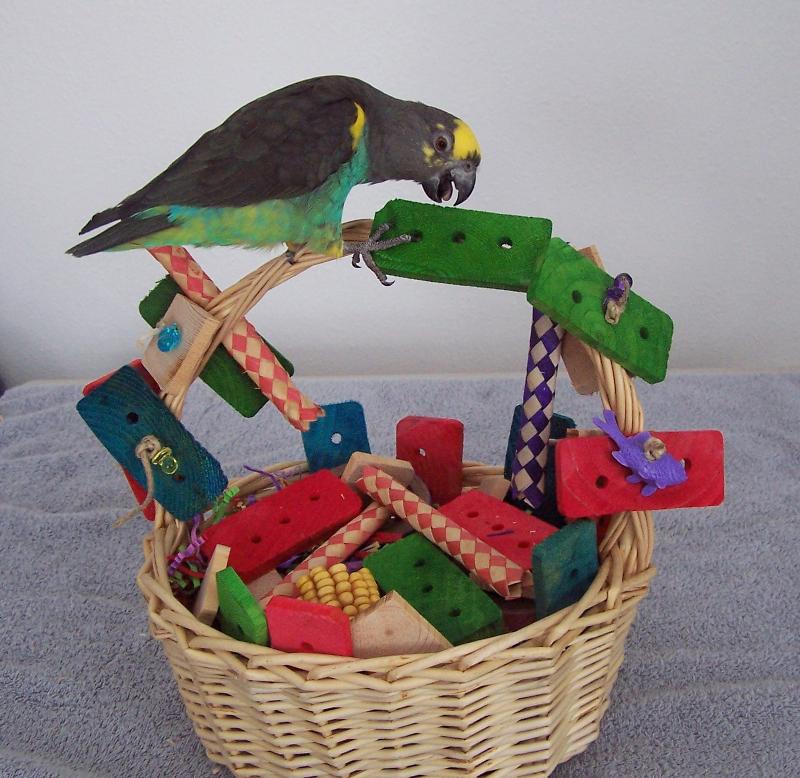 Baskets make great alternate play areas for parrots. You can carry the basket with you from room to room. A good basket for this purpose is made of untreated wicker or willow. Look for baskets with wide bases and sturdy handles. You don't want the handle too high off the basket. A shorter handle will provide more balance when your bird plays on it. Tie on toys to the sides of the basket and handle for added interest and activity. You can create a foraging opportunity by filling the basket with toys, whole vegetables, fruit or nuts and anything else that your bird is particularly interested in.
Baskets make great alternate play areas for parrots. You can carry the basket with you from room to room. A good basket for this purpose is made of untreated wicker or willow. Look for baskets with wide bases and sturdy handles. You don't want the handle too high off the basket. A shorter handle will provide more balance when your bird plays on it. Tie on toys to the sides of the basket and handle for added interest and activity. You can create a foraging opportunity by filling the basket with toys, whole vegetables, fruit or nuts and anything else that your bird is particularly interested in. Try baking your favorite birdie bread recipes in mini-muffin pans. Use the end of a wooden spoon to put a hole in each muffin before putting them in the oven. This enables you to string the birdie bread on toys which creates a foraging experience for your parrot. Here is my parrot's favorite bird bread recipe:
Try baking your favorite birdie bread recipes in mini-muffin pans. Use the end of a wooden spoon to put a hole in each muffin before putting them in the oven. This enables you to string the birdie bread on toys which creates a foraging experience for your parrot. Here is my parrot's favorite bird bread recipe: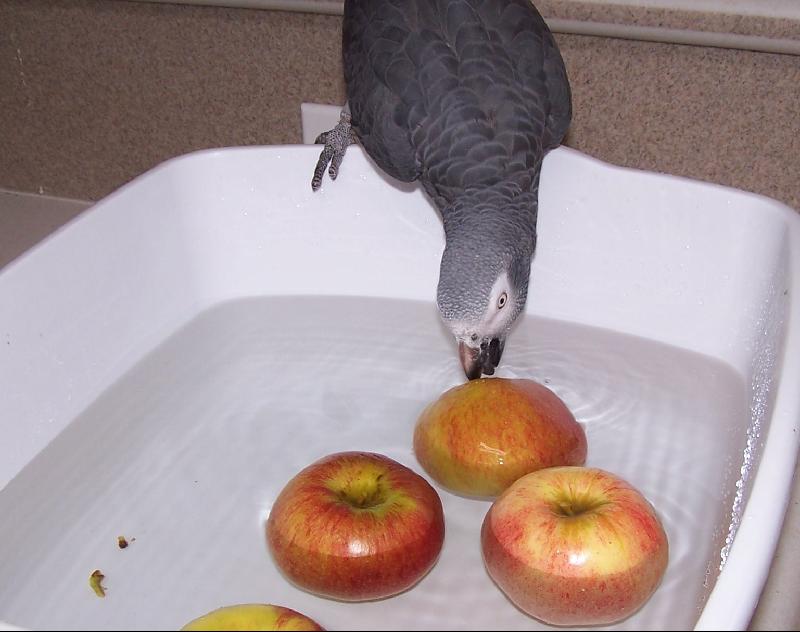 Fall is the season for fresh apples. Though many apple varieties are sold in supermarkets all year round, the freshest apples are available from September through November. I found some wonderful apples on sale at the grocers this past week and also discovered, quite by accident, a great new parrot enrichment activity.
Fall is the season for fresh apples. Though many apple varieties are sold in supermarkets all year round, the freshest apples are available from September through November. I found some wonderful apples on sale at the grocers this past week and also discovered, quite by accident, a great new parrot enrichment activity.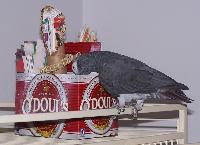 As I was getting ready to toss out a cardboard 6-pack bottled beer carrier, I remembered seeing one put to use in a Talkeetna, Alaska restaurant as a napkin and plastic flatware caddy. I thought I could use that idea to make a simple parrot toy.
As I was getting ready to toss out a cardboard 6-pack bottled beer carrier, I remembered seeing one put to use in a Talkeetna, Alaska restaurant as a napkin and plastic flatware caddy. I thought I could use that idea to make a simple parrot toy. I recently received a large box of toy making supplies. I didn't have time to put the toy parts away in the craft room and left the box in the dining room, next to one of the bird cages. I let the parrots out for the evening and it didn't take Zorba long to notice something new in his area. I looked over to see him standing on the box chewing away to get at whatever was inside. My first instinct was to put the box away, when I realized this was a new activity for him and there was no reason he couldn't chew on the box as it contained parrot toy parts meant for him anyway.
I recently received a large box of toy making supplies. I didn't have time to put the toy parts away in the craft room and left the box in the dining room, next to one of the bird cages. I let the parrots out for the evening and it didn't take Zorba long to notice something new in his area. I looked over to see him standing on the box chewing away to get at whatever was inside. My first instinct was to put the box away, when I realized this was a new activity for him and there was no reason he couldn't chew on the box as it contained parrot toy parts meant for him anyway.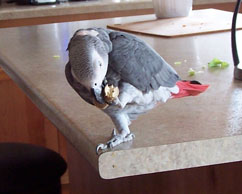 I recently got a clay pot cooker and have been experimenting with adding wine to the pot to flavor roasts, poultry and stews. It occurred to me that instead of throwing away the wine cork, I could offer it to the parrots as a foot toy. I will usually leave one out on the counter for a parrot to "happen" by it and think he's found a prize. Or I put the corks into toy boxes, toy pails, or toy bowls along with other toy parts. Usually my birds will be busy throwing everything out of their toy box or bowl eagerly searching for the nutri-berry, nut or other treat hidden in amongst the toy parts. I have observed that instead of immediately throwing the cork aside, they stop and hold the cork and chew and shred it to pieces before throwing it to the floor or the bottom of the cage. While this idea is probably not a new one to many parrot owners; wine corks have only recently become a popular foot toy among my flock.
I recently got a clay pot cooker and have been experimenting with adding wine to the pot to flavor roasts, poultry and stews. It occurred to me that instead of throwing away the wine cork, I could offer it to the parrots as a foot toy. I will usually leave one out on the counter for a parrot to "happen" by it and think he's found a prize. Or I put the corks into toy boxes, toy pails, or toy bowls along with other toy parts. Usually my birds will be busy throwing everything out of their toy box or bowl eagerly searching for the nutri-berry, nut or other treat hidden in amongst the toy parts. I have observed that instead of immediately throwing the cork aside, they stop and hold the cork and chew and shred it to pieces before throwing it to the floor or the bottom of the cage. While this idea is probably not a new one to many parrot owners; wine corks have only recently become a popular foot toy among my flock.